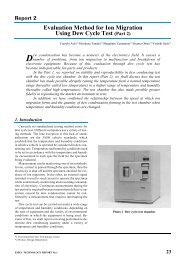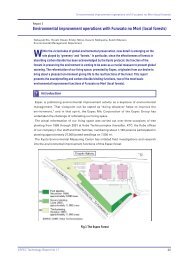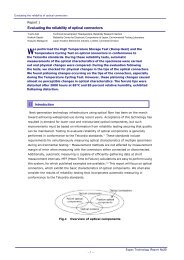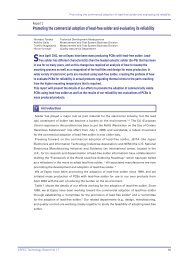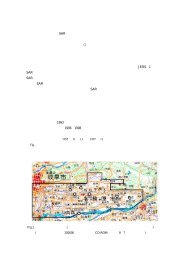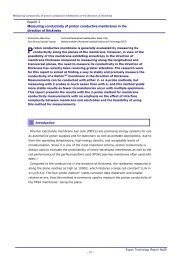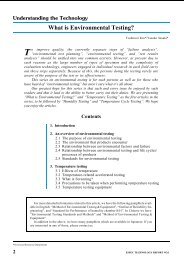download
download
download
Create successful ePaper yourself
Turn your PDF publications into a flip-book with our unique Google optimized e-Paper software.
3-2 Ion Migration Test Method for Printed<br />
Circuit Boards<br />
As high humidity test methods for printed circuit<br />
boards, tests are performed at 40°C, 90%RH + bias and<br />
at 85°C, 85%RH + bias.<br />
However,<br />
· Short circuit failures between the metal patterns lasting<br />
for a long period are rare, but failures involving<br />
unstable flow of leak current are common.<br />
· When current flows along the metal extended as dendrites,<br />
sometimes during the test the metal separates<br />
like a fuse and recovery occurs from insulation defects.<br />
Because of that, it is desirable to continuously measure<br />
leak current during the test to observe the growth of ion<br />
migration.<br />
Recently, to increase test acceleration beyond the<br />
formula of high temperature + high humidity + bias, the<br />
spotlight is being focused on dew cycle testing, such as<br />
5°C, 60%RH « 25°C 90%RH. Companies, especially<br />
automobile manufacturers, are setting company standards<br />
for this type of test.<br />
(For information on dew cycle testing, refer to Report<br />
1 and Report 2 in Technology Report No.1.)<br />
For your reference, we are providing below a list of<br />
measure to prevent ion migration in table 5, and a list of<br />
metals causing ion migration in table 6.<br />
Metals causing by<br />
distilled water<br />
+ electric field* 1<br />
Bismuth<br />
Cadmium<br />
Copper<br />
Lead<br />
Silver<br />
Tin<br />
Zinc<br />
Table 6 Metals causing ion migration<br />
Metals causing by<br />
distilled water + electric<br />
field*1 +halogen* 2<br />
Gold<br />
Indium<br />
Paladium<br />
Platinum<br />
Table 5 Ion migration prevention measures<br />
Ion Migration Prevention Measures<br />
1. Control the quantity of water vapor.<br />
2. Prevent dew condensation.<br />
3. Avoid environments with sudden changes in<br />
temperature.<br />
4. Examine materials for protective films.<br />
5. Prevent contamination by foreign matter.<br />
6. Wash products properly.<br />
7. Study the moisture absorption characteristics<br />
of flux before using.<br />
8. Have no electrostatic focusing at the anode.<br />
9. Increase the distance between the terminals.<br />
10. Use lower voltage and lower energy consumption.<br />
11. Increase the density of printed circuit board<br />
material.<br />
12. Eliminate areas of exposed metal.<br />
13. Improve bonding between different materials<br />
on the printed circuit board.<br />
14. Air condition installation sites. (Lower humidity.)<br />
15. Improve resin materials.<br />
Metals only causing with other<br />
conditions<br />
Aluminum<br />
Antimony<br />
Chrome<br />
Iron<br />
Nickel<br />
Rhodium<br />
Tantalum<br />
Titanium<br />
Vanadium<br />
Note: * 1 At distance of 1 mm, bias has been changed from 1 to 45 V DC.<br />
* 2 A 0.001 to 0.1 mole solution of NaCl or KCl.<br />
A.Der Marderosian: From the “International Microelectronics Symposium”, pp. 134 - 141, 1978<br />
8 ESPEC TECHNOLOGY REPORT NO.2



